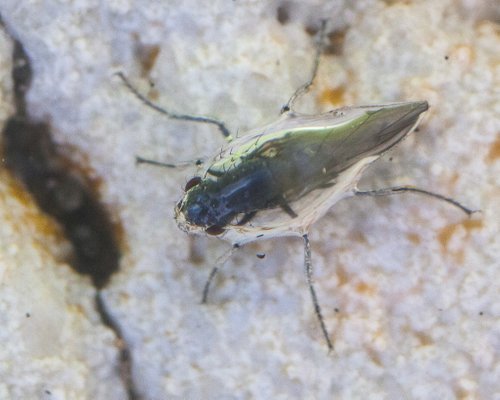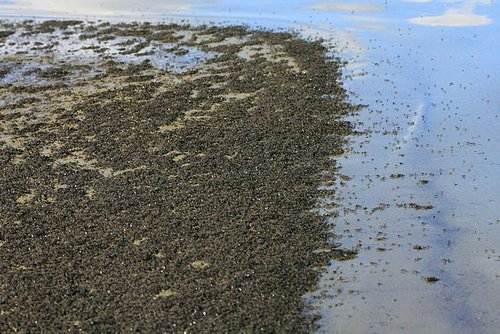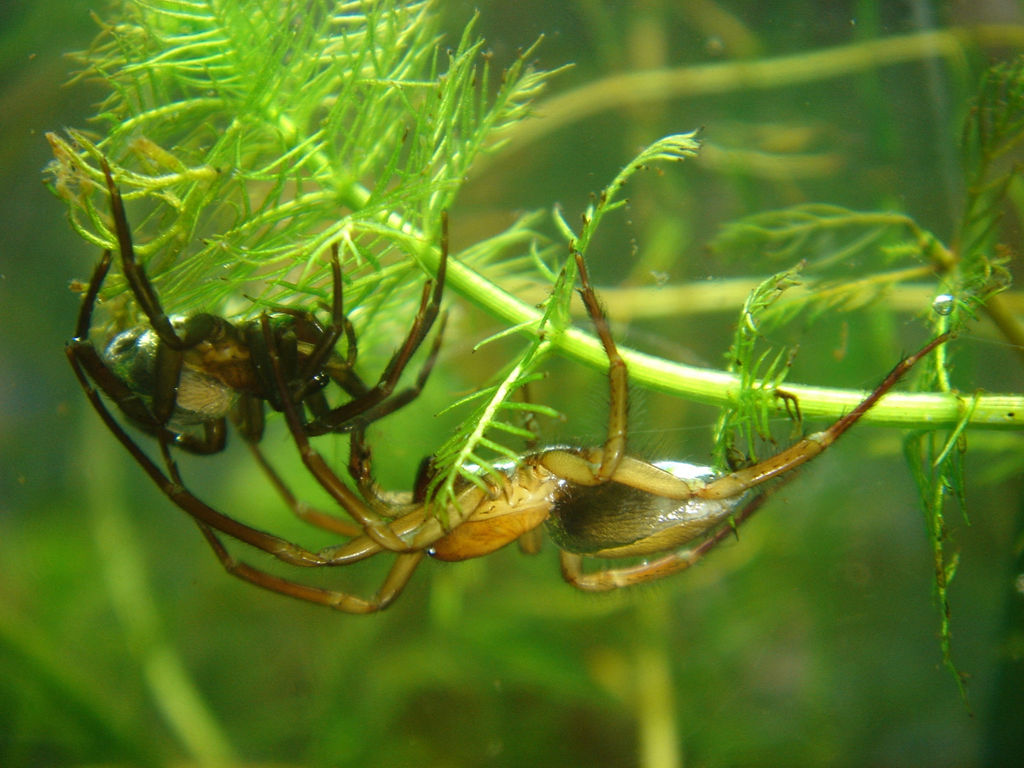Plunging Underwater: Meet the Scuba Fly!
Mono County in California is home to a shallow lake. Mono Lake is an important resting place for millions of migratory birds and hosts important species such as brine shrimps and the (so called) alkali flies (scientifically known as Ephydra hians).
The diving flies have surprised Mark Twain, who back in 1872 would describe in his travel book Roughing It
There are no fish in Mono Lake--no frogs, no snakes, no polliwigs--nothing, in fact, that goes to make life desirable.
[…]
Then there is a fly, which looks something like our house fly. […] You can hold them under water as long as you please--they do not mind it--they are only proud of it.
[…]
source
A few months ago, Floris van Breugel and Michael H. Dickinson published a study in which they identify the behavior of the Ephydra Hians and explain their physical mechanisms.
Why do these flies manage to dive into the Mono Lake's waters and how do they do it?

Alkali fly (Ephydra hians) under water inside of its protective air bubble at Mono Lake, CA. - 1 August 2015, 12:25:52
About Ephydra Hians
The alkali fly has a dark brown body and brownish wings. It can grow up to 7 mm. Its thorax has a metallic texture. They are mostly found in the United States, but also in Mexico or Canada.
This species (full name Ephydra hudropyrus hians) was discovered in 1830 by a scientist with the name “Say”. The flies used to constitute a vital nourishing meal for the Native Americans due to their high levels of protein, also serving as a means of trade with other Native Americans.
Behaviour of Alkali Flies
They have been observed to have a peculiar behavior during the summer time. A vast number of alkali flies visit the Mono Lake in California and dive in the lake in order to eat. They feed on plankton and they have no predators to be afraid of during lunch time!

In addition, the females have a safe place to lay their eggs: The bottom of the lake.
After the eggs hatch, the juvenile flies (called larvae) remain underwater and feed on algae until they grow big enough. When the larvae become adults, they will emerge to the surface and during their life span they remain on the shore.
How does the fly dive?
In order to be able to get into the water, forces 16 times their weight are applied.
Check out this video to watch how the fly enters the water.
Being underwater means a lot of food for them and no predators. The can walk underwater, eat as much as they want and lay their eggs.
To something the size of a tiny fly, water's surface tension is powerful, making it a deadly sticky trap. All insects need to be water repellant, or hydrophobic, in order to coexist with rain and dew in their environments. Most are able to accomplish this by sporting a coating of short bristly hairs covered in a waxy substance, which allows them to repel water for the most part.
The substance of the Mono Lake’s surface, which contains “a thin layer of negatively charged carbonate ions” creates a dangerous environment for insects going near the water’s surface because it ‘pulls the insects down’ and causes them to get wet.
However, the alkali fly, due to a phenomenon called “superhydrophobicity”, creates a bubble around it and with the oxygen supply, getting into the water becomes possible. A significant observation is that the bubble does not affect the flies’ eyes!
The reasons why the flies are able to dive underwater are:
Their body in average has more hair than other flies
The flies coat their bodies with wax that repels the water
The flies’ claws are quite large and provide them with additional power
The scientists attempted to dissolve the flies’ wax overlay; which caused a lack of bubble creation and thus the inability of the flies to dive underwater.
The scientists tested also different flies’ species under same circumstances and only the alkali ones were able to create the bubble and dive in.
You may want to watch this Video where the fly surfaces, remaining dry.
I also recommend this (1m 42sec) video by Caltech - narrated by M. Dickinson where you can see the fly during the whole process!
(Attention, contains upclose shots of the flies, some may find disturbing)
Are there other insects that dive underwater?
Believe it or not, alkali flies are not the only insects that can live and breath underwater. I am sure that biologists that might read this article can share more information.
In the meantime you (probably) would like to know that there are beetles actually called water beetles. These beetles have the ability to live in the water (be it fresh or marine). Similarly like alkali flies, the water beetles also use an air bubble which provides them with air supplies.
During my searches I also found out (@ruth-girl might even be inspired by it!!) that there is such a species as a diving bell spider, which is the only known spider to be able to live almost entirely under the water. These spiders live, mate, eat, rest, lay their eggs underwater and only visit the surface to replenish their oxygen (!)

Pair of Diving bell spiders (♀ left, ♂ right), found at Wien Prater park in Vienna, Austria.
Image by Baupi source Licence CC BY-SA 3.0
Affects - New Discoveries
What does the future hold?
As Dickinson says, the scientists are surprised by the evolution of the Mono Lake flies, which found a way of remaining hydrophobic and amplified the normal tools that insects bare. The changes they have gone through, can allow certain species to create brand new ecological niches.
The science has many ways to move forward after such studies and discoveries. The chemistry of waxes used by insects can be studied further and what is also amazing in terms of neurobiology is the ability of the flies not only to plunge in the water but also to crawl under it!
Nature holds the key to many of humanity's problems and queries. We need to make sure that we respect it in the process of science and studies. We need to love nature; but it is important that we get to know it in order to learn more, admire, be inspired.
I would like to close this post with a quote from the 'Roughing it' travel guide by Mark Twain and the way he describes nature..
All things have their uses and their part and proper place in Nature's economy: the ducks eat the flies--the flies eat the worms--the Indians eat all three--the wild cats eat the Indians--the white folks eat the wild cats--and thus all things are lovely.
References and Further Reading retrieved 10-13 April 2018
- https://physicsworld.com/a/insects-inspire-water-repellent-material/
- http://twainhartevisitor.com/marktwain/story.php?author=marktwain&story=monolake
- http://www.caltech.edu/news/strange-case-scuba-diving-fly-80435
- https://www.nature.com/news/how-alkali-flies-stay-dry-1.23027
- http://www.pnas.org/content/114/51/13483

@steemstem is a community which supports posts about Science, Technology, Engineering or Mathematics.
Browse the #steemSTEM tag or visit SteemSTEM on discord










Comments